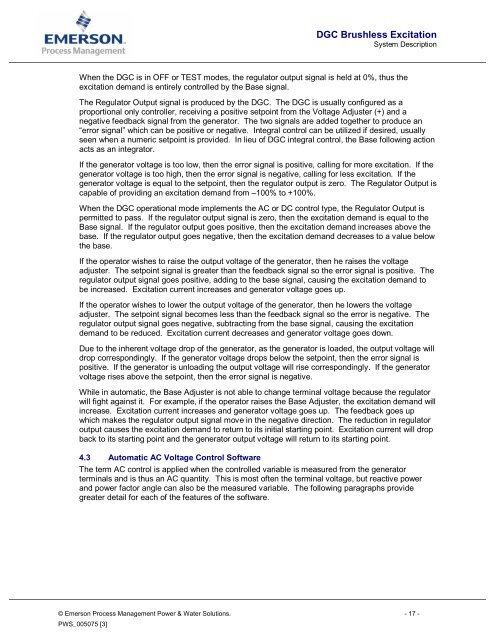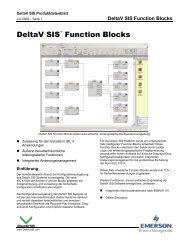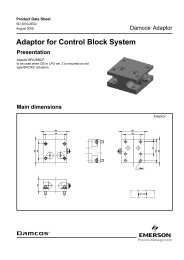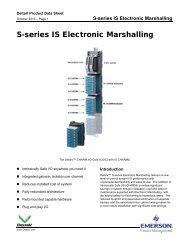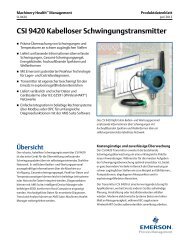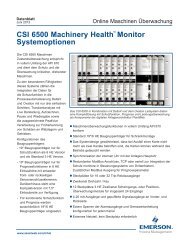DGC Brushless Excitation - Emerson Process Management
DGC Brushless Excitation - Emerson Process Management
DGC Brushless Excitation - Emerson Process Management
You also want an ePaper? Increase the reach of your titles
YUMPU automatically turns print PDFs into web optimized ePapers that Google loves.
<strong>DGC</strong> <strong>Brushless</strong> <strong>Excitation</strong><br />
System Description<br />
When the <strong>DGC</strong> is in OFF or TEST modes, the regulator output signal is held at 0%, thus the<br />
excitation demand is entirely controlled by the Base signal.<br />
The Regulator Output signal is produced by the <strong>DGC</strong>. The <strong>DGC</strong> is usually configured as a<br />
proportional only controller, receiving a positive setpoint from the Voltage Adjuster (+) and a<br />
negative feedback signal from the generator. The two signals are added together to produce an<br />
“error signal” which can be positive or negative. Integral control can be utilized if desired, usually<br />
seen when a numeric setpoint is provided. In lieu of <strong>DGC</strong> integral control, the Base following action<br />
acts as an integrator.<br />
If the generator voltage is too low, then the error signal is positive, calling for more excitation. If the<br />
generator voltage is too high, then the error signal is negative, calling for less excitation. If the<br />
generator voltage is equal to the setpoint, then the regulator output is zero. The Regulator Output is<br />
capable of providing an excitation demand from –100% to +100%.<br />
When the <strong>DGC</strong> operational mode implements the AC or DC control type, the Regulator Output is<br />
permitted to pass. If the regulator output signal is zero, then the excitation demand is equal to the<br />
Base signal. If the regulator output goes positive, then the excitation demand increases above the<br />
base. If the regulator output goes negative, then the excitation demand decreases to a value below<br />
the base.<br />
If the operator wishes to raise the output voltage of the generator, then he raises the voltage<br />
adjuster. The setpoint signal is greater than the feedback signal so the error signal is positive. The<br />
regulator output signal goes positive, adding to the base signal, causing the excitation demand to<br />
be increased. <strong>Excitation</strong> current increases and generator voltage goes up.<br />
If the operator wishes to lower the output voltage of the generator, then he lowers the voltage<br />
adjuster. The setpoint signal becomes less than the feedback signal so the error is negative. The<br />
regulator output signal goes negative, subtracting from the base signal, causing the excitation<br />
demand to be reduced. <strong>Excitation</strong> current decreases and generator voltage goes down.<br />
Due to the inherent voltage drop of the generator, as the generator is loaded, the output voltage will<br />
drop correspondingly. If the generator voltage drops below the setpoint, then the error signal is<br />
positive. If the generator is unloading the output voltage will rise correspondingly. If the generator<br />
voltage rises above the setpoint, then the error signal is negative.<br />
While in automatic, the Base Adjuster is not able to change terminal voltage because the regulator<br />
will fight against it. For example, if the operator raises the Base Adjuster, the excitation demand will<br />
increase. <strong>Excitation</strong> current increases and generator voltage goes up. The feedback goes up<br />
which makes the regulator output signal move in the negative direction. The reduction in regulator<br />
output causes the excitation demand to return to its initial starting point. <strong>Excitation</strong> current will drop<br />
back to its starting point and the generator output voltage will return to its starting point.<br />
4.3 Automatic AC Voltage Control Software<br />
The term AC control is applied when the controlled variable is measured from the generator<br />
terminals and is thus an AC quantity. This is most often the terminal voltage, but reactive power<br />
and power factor angle can also be the measured variable. The following paragraphs provide<br />
greater detail for each of the features of the software.<br />
© <strong>Emerson</strong> <strong>Process</strong> <strong>Management</strong> Power & Water Solutions. - 17 -<br />
PWS_005075 [3]


